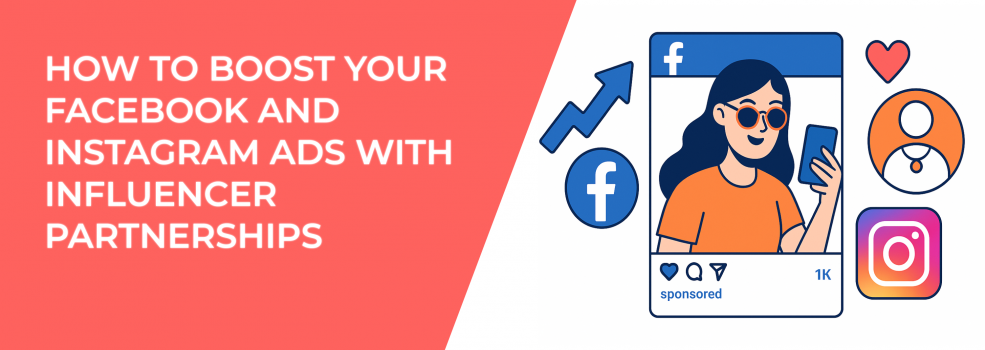Influencer marketing is everywhere, and for good reason. It can add a layer of social credibility your paid Facebook and Instagram ads can’t replicate on their own.
But here’s the thing: it’s not always effective. Sometimes it’s wasteful. Sometimes it looks good on the surface but delivers very little when you dig into the data. And sometimes brands spend too much time trying to look authentic instead of being strategic.
If you’re going to combine influencer marketing with paid ads, you need a sharper approach. One that avoids vanity partnerships, prioritizes fit over flash, and uses targeting tools to turn attention into action.
Here’s how to make influencer partnerships work and what to watch out for.
Influencers can help, but only when it makes sense
There’s a tendency to assume that influencer content is more trusted, more engaging, and more persuasive. Sometimes it is. But audiences are more skeptical than ever. People can spot a sponsored post from a mile away. The trust gap that influencers once helped bridge isn’t what it used to be.
This means the bar is higher. Your product has to make sense in the context of the influencer’s world. If the fit feels forced or the message is off, it won’t just underperform — it could damage your brand.
Ask these questions before investing in a partnership:
-
Does the influencer talk to people who’d actually buy your product?
-
Does their content style work well as ad creative — or just as entertainment?
-
Do they have a pattern of promoting things they don’t use?
If the answer to any of these raises red flags, move on. Plenty of brands spend thousands on partnerships that generate no return — or worse, confuse their audience.
How to choose influencers who won’t waste your budget
The biggest mistake advertisers make? Prioritizing reach over relevance.
Big followings can be impressive, but they don’t tell you much about who’s actually paying attention — or whether those people care about your product.
Look deeper. Before signing any deal, evaluate:
1. Audience relevance
Make sure the influencer’s followers overlap with your ideal customer profile. For a deeper dive into refining your audience strategy before selecting influencers, read our Facebook Ad Targeting 101 guide.
You can find the right audience for your influencer ads and content inside the overlap of the influencer's audience and your ideal target customer profile.
2. Real engagement
Look at the ratio of comments and shares to followers. Are people responding with interest — or is it just empty likes?
3. Content track record
Have they done brand deals before? If so, how did those perform? Were they selling five different products last month?
4. Message control
Some influencers drift off-brand or deliver unclear messaging. If you’re investing in a campaign, make sure you agree on what’s being said and why.
Also, be careful with overexposed influencers. If they’re constantly posting sponsored content, their audience has likely tuned out.
Micro-influencers are often more useful here — they tend to be more focused, more responsive, and more aligned with niche audiences.
Using influencer content in paid ads: where the real value starts
One of the smartest ways to make influencer content work is to treat it as ad creative — not just a one-time post.
When done right, it’s more cost-effective, more scalable, and easier to test than producing everything in-house.
Here’s what to do:
Run influencer content through Ads Manager
Don’t rely on organic reach. Use Meta’s branded content tools to get whitelisting access. This lets you promote the influencer’s content under their name, using your targeting settings. The post looks familiar and credible to the audience — but it’s backed by your budget.
Fit the content to the funnel
Use influencer content at multiple stages:
-
Top of funnel: Fast, relatable product intros. Personal stories or short demos.
-
Mid-funnel: Reviews, comparisons, or deeper dives into product features.
-
Bottom of funnel: Social proof, offers, deadlines, or FAQs.
Keep it flexible, but on-message
Influencers don’t need scripts, but they do need structure. Tell them what the product does, who it’s for, and what you want people to take away. Then let them say it in their own voice, just not at the cost of clarity.
Test multiple versions
A common issue: brands run influencer content once and assume it’s either good or bad. In reality, performance often comes down to the caption, the opening three seconds, or the call-to-action. Test different variations.
Retarget the right people, not everyone
Another issue in influencer marketing? No follow-through.
Many campaigns drive engagement but fail to close the loop. People see the post, maybe even like it, then disappear. If you’re not retargeting those users, you’re leaving potential conversions on the table.
Here’s how to fix that:
- Build engagement Custom Audiences. Inside Meta, you can create audiences based on who watched a video, liked a post, clicked a link, or viewed a Story. That’s your warm segment.
- Then retarget with intent. Don’t repeat the same influencer post. Follow up with:
-
Focused product offers
-
Customer reviews
-
Deeper brand storytelling
-
Urgency (e.g. expiring discount, limited edition)
This way, you’re not just reaching more people — you’re moving the right people toward a decision.
And once you’ve collected enough data, use these warm audiences to build Lookalikes. That gives you fresh prospects who resemble your most engaged users.
If you're not sure how to build custom audiences or retarget people, follow this step-by-step guide to setting up Facebook retargeting.
Track real impact
Influencer marketing often leans too hard on appearance. Nice visuals, big reach, lots of likes. But those don’t always mean sales.
To evaluate performance, you need real numbers tied to business outcomes:
-
CPM for cost efficiency,
-
CTR to see if people care enough to click,
-
CPA and ROAS to judge actual performance.
Use tracking links. Tag each campaign clearly in Meta Ads Manager. Set up your Pixel or Conversions API. And compare influencer-led ads to your top-performing in-house creatives: don’t just assume one is better because it looks good.
Also, track sentiment. Are people tagging others? Asking questions? Ignoring it? Engagement type matters more than volume.
And if something underperforms, figure out why. Was it a bad fit? Weak messaging? Wrong audience? Not all influencer content works, and you shouldn’t force it.
If your influencer-led ads are running but not converting, take a look at these common reasons Facebook ads fail — and how to fix them.
Final thoughts
Influencer marketing is not a magic fix. It can add value — or it can waste time and budget. The difference lies in how carefully you choose your partners, how well you structure the campaign, and how closely you track performance.
Used well, influencers can help your Facebook and Instagram ads:
-
Feel more personal,
-
Reach more relevant audiences,
-
Build trust faster,
-
Deliver better ROI.
But it only works when the strategy is clear, the execution is disciplined, and the content is aligned with what your audience actually wants.
So before you launch another sponsored post or partner with another creator, ask the hard questions. What are you really trying to achieve, and is this the right way to do it?

